Marketing Strategy Analysis: Huawei Technologies and Delta Telecom
VerifiedAdded on 2023/04/07
|32
|4948
|58
Report
AI Summary
This report provides a comprehensive analysis of the marketing strategies of Huawei Technologies Ltd and Delta Telecom. Part 1 focuses on Huawei, examining its executive summary, situational analysis, SWOT and PESTLE analyses, competitive advantages, and PIPE strategy. It also includes a competitive profile matrix and perceptual map. Part 2 shifts to Delta Telecom, exploring its marketing strategies, including brand name, integrated marketing communications objectives, product description, logo, segmentation, targeting & positioning analysis, and marketing mix (4Ps). The report concludes with recommended objectives, SMART goals, and recommendations for both companies, offering a detailed overview of their market positions and strategic approaches. The analysis covers market environments, competitive advantages, and the evolution of telecommunications retailing, and offers a detailed overview of their market positions and strategic approaches.
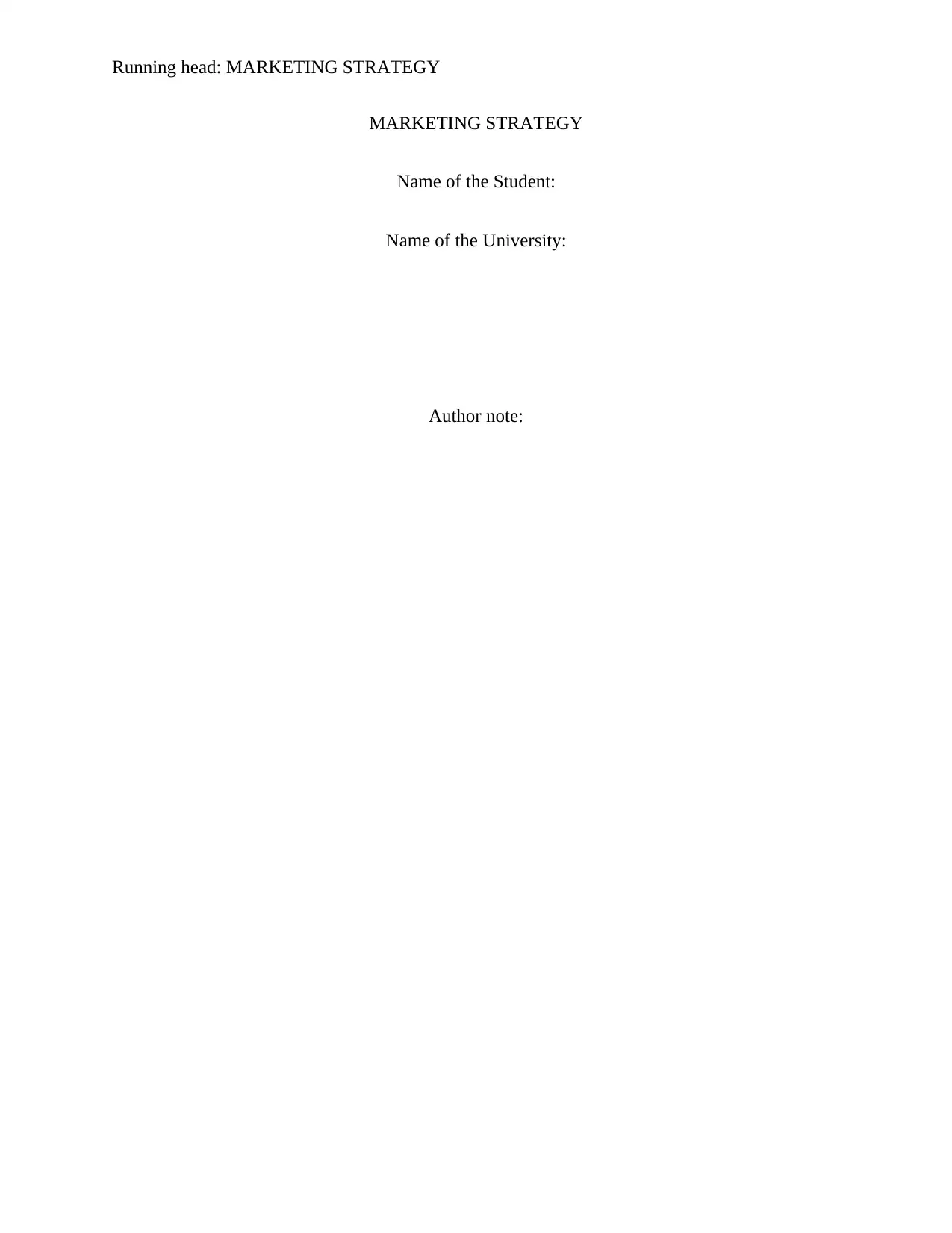
Running head: MARKETING STRATEGY
MARKETING STRATEGY
Name of the Student:
Name of the University:
Author note:
MARKETING STRATEGY
Name of the Student:
Name of the University:
Author note:
Paraphrase This Document
Need a fresh take? Get an instant paraphrase of this document with our AI Paraphraser
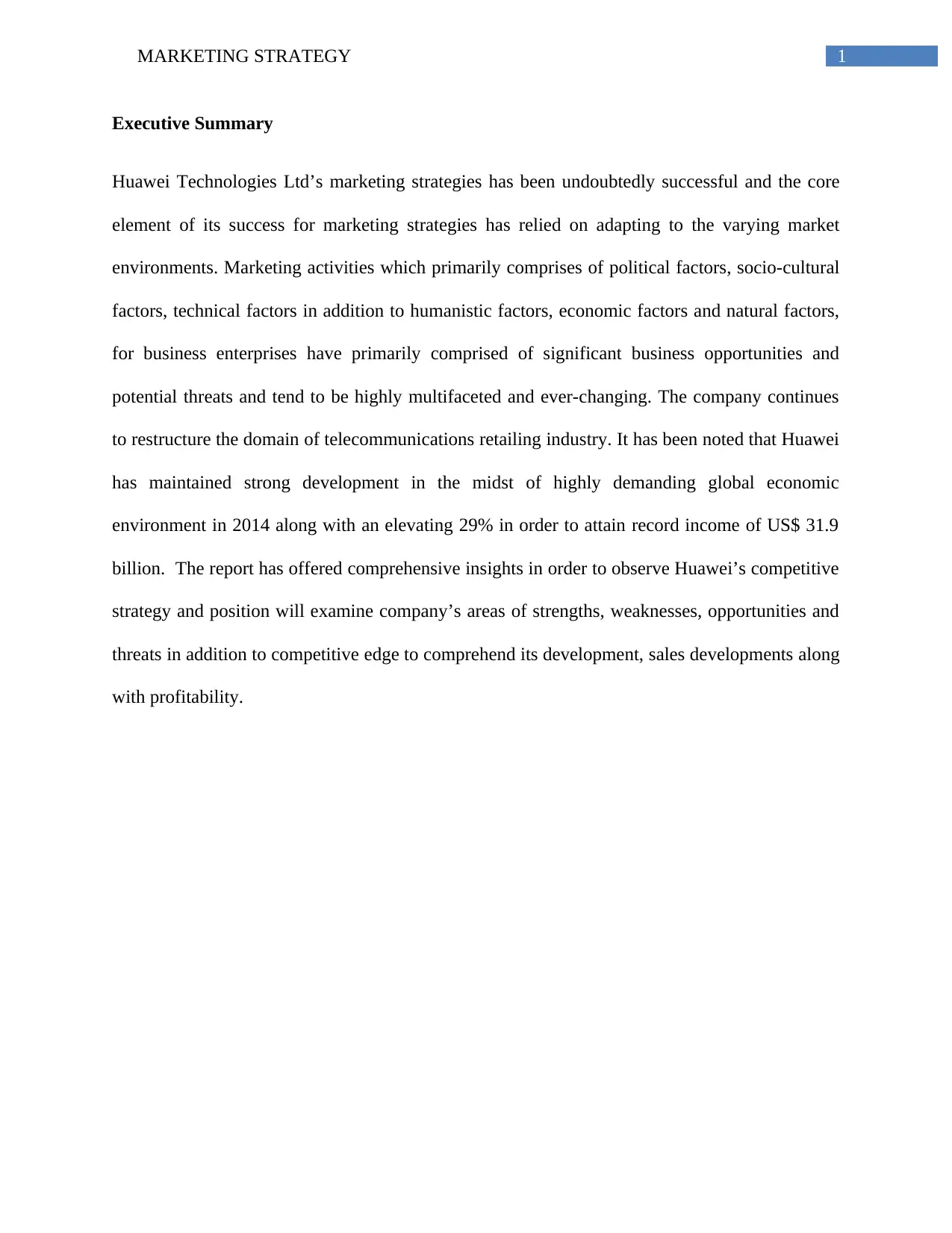
1MARKETING STRATEGY
Executive Summary
Huawei Technologies Ltd’s marketing strategies has been undoubtedly successful and the core
element of its success for marketing strategies has relied on adapting to the varying market
environments. Marketing activities which primarily comprises of political factors, socio-cultural
factors, technical factors in addition to humanistic factors, economic factors and natural factors,
for business enterprises have primarily comprised of significant business opportunities and
potential threats and tend to be highly multifaceted and ever-changing. The company continues
to restructure the domain of telecommunications retailing industry. It has been noted that Huawei
has maintained strong development in the midst of highly demanding global economic
environment in 2014 along with an elevating 29% in order to attain record income of US$ 31.9
billion. The report has offered comprehensive insights in order to observe Huawei’s competitive
strategy and position will examine company’s areas of strengths, weaknesses, opportunities and
threats in addition to competitive edge to comprehend its development, sales developments along
with profitability.
Executive Summary
Huawei Technologies Ltd’s marketing strategies has been undoubtedly successful and the core
element of its success for marketing strategies has relied on adapting to the varying market
environments. Marketing activities which primarily comprises of political factors, socio-cultural
factors, technical factors in addition to humanistic factors, economic factors and natural factors,
for business enterprises have primarily comprised of significant business opportunities and
potential threats and tend to be highly multifaceted and ever-changing. The company continues
to restructure the domain of telecommunications retailing industry. It has been noted that Huawei
has maintained strong development in the midst of highly demanding global economic
environment in 2014 along with an elevating 29% in order to attain record income of US$ 31.9
billion. The report has offered comprehensive insights in order to observe Huawei’s competitive
strategy and position will examine company’s areas of strengths, weaknesses, opportunities and
threats in addition to competitive edge to comprehend its development, sales developments along
with profitability.
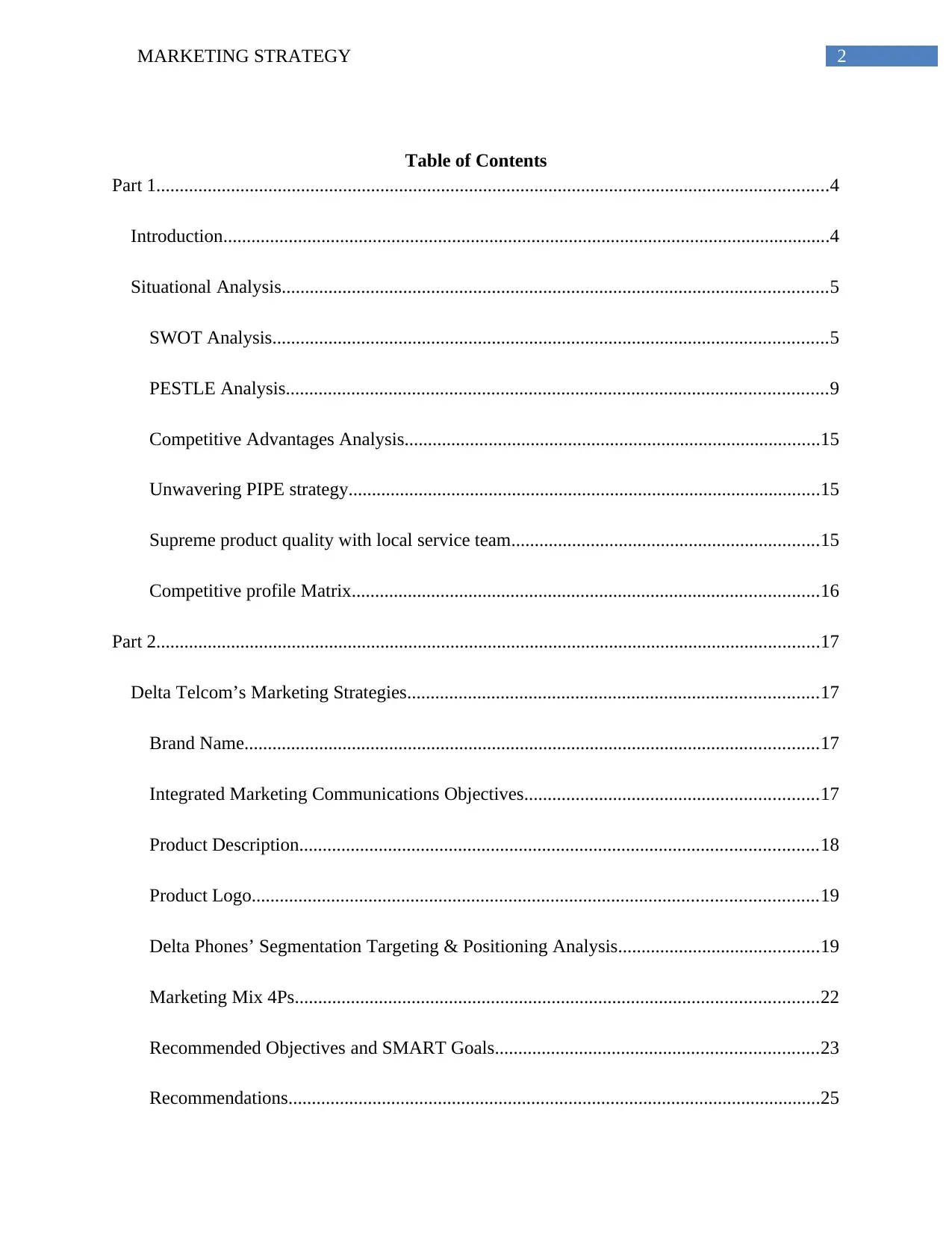
2MARKETING STRATEGY
Table of Contents
Part 1................................................................................................................................................4
Introduction..................................................................................................................................4
Situational Analysis.....................................................................................................................5
SWOT Analysis.......................................................................................................................5
PESTLE Analysis....................................................................................................................9
Competitive Advantages Analysis.........................................................................................15
Unwavering PIPE strategy.....................................................................................................15
Supreme product quality with local service team..................................................................15
Competitive profile Matrix....................................................................................................16
Part 2..............................................................................................................................................17
Delta Telcom’s Marketing Strategies........................................................................................17
Brand Name...........................................................................................................................17
Integrated Marketing Communications Objectives...............................................................17
Product Description...............................................................................................................18
Product Logo.........................................................................................................................19
Delta Phones’ Segmentation Targeting & Positioning Analysis...........................................19
Marketing Mix 4Ps................................................................................................................22
Recommended Objectives and SMART Goals.....................................................................23
Recommendations..................................................................................................................25
Table of Contents
Part 1................................................................................................................................................4
Introduction..................................................................................................................................4
Situational Analysis.....................................................................................................................5
SWOT Analysis.......................................................................................................................5
PESTLE Analysis....................................................................................................................9
Competitive Advantages Analysis.........................................................................................15
Unwavering PIPE strategy.....................................................................................................15
Supreme product quality with local service team..................................................................15
Competitive profile Matrix....................................................................................................16
Part 2..............................................................................................................................................17
Delta Telcom’s Marketing Strategies........................................................................................17
Brand Name...........................................................................................................................17
Integrated Marketing Communications Objectives...............................................................17
Product Description...............................................................................................................18
Product Logo.........................................................................................................................19
Delta Phones’ Segmentation Targeting & Positioning Analysis...........................................19
Marketing Mix 4Ps................................................................................................................22
Recommended Objectives and SMART Goals.....................................................................23
Recommendations..................................................................................................................25
⊘ This is a preview!⊘
Do you want full access?
Subscribe today to unlock all pages.

Trusted by 1+ million students worldwide
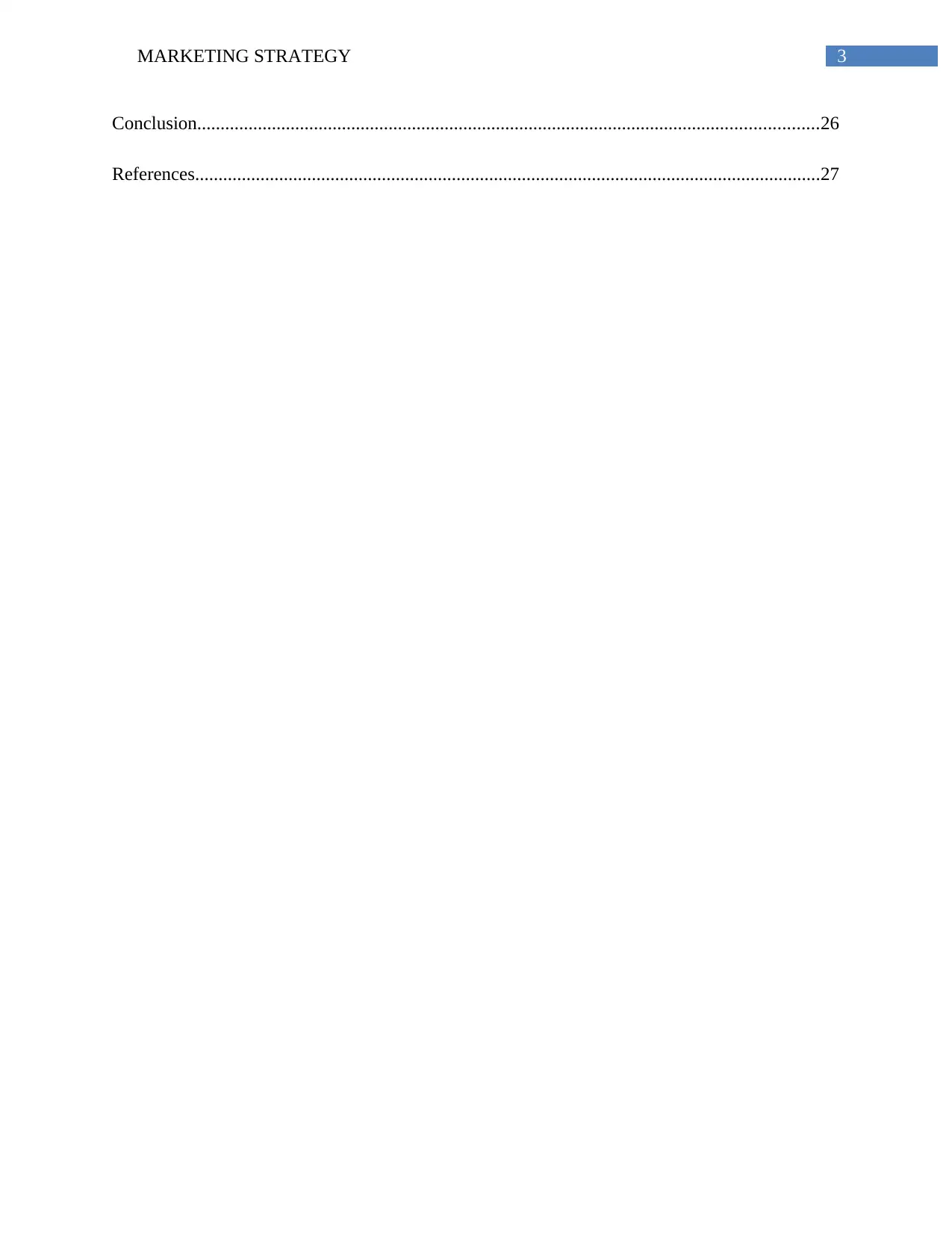
3MARKETING STRATEGY
Conclusion.....................................................................................................................................26
References......................................................................................................................................27
Conclusion.....................................................................................................................................26
References......................................................................................................................................27
Paraphrase This Document
Need a fresh take? Get an instant paraphrase of this document with our AI Paraphraser
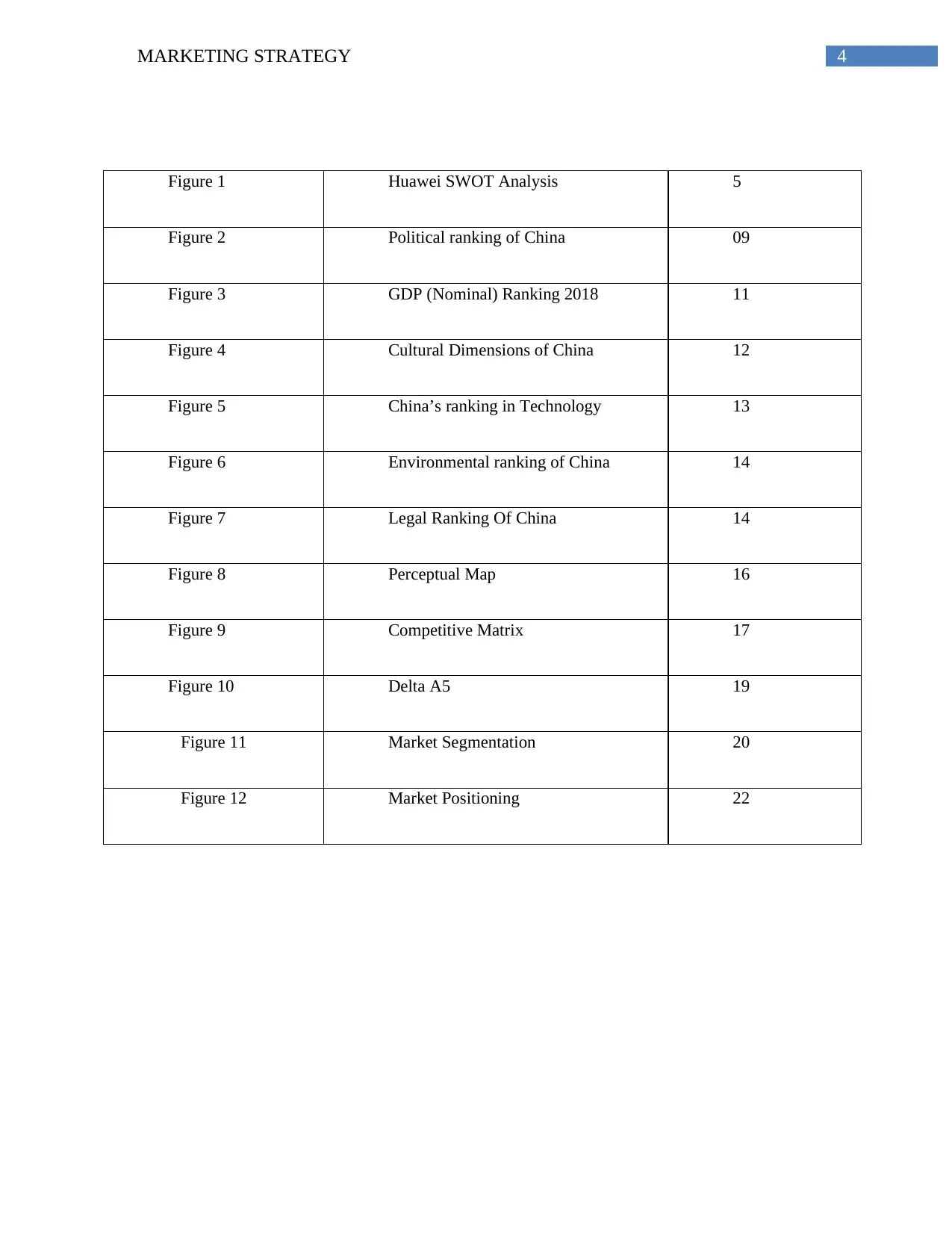
4MARKETING STRATEGY
Figure 1 Huawei SWOT Analysis 5
Figure 2 Political ranking of China 09
Figure 3 GDP (Nominal) Ranking 2018 11
Figure 4 Cultural Dimensions of China 12
Figure 5 China’s ranking in Technology 13
Figure 6 Environmental ranking of China 14
Figure 7 Legal Ranking Of China 14
Figure 8 Perceptual Map 16
Figure 9 Competitive Matrix 17
Figure 10 Delta A5 19
Figure 11 Market Segmentation 20
Figure 12 Market Positioning 22
Figure 1 Huawei SWOT Analysis 5
Figure 2 Political ranking of China 09
Figure 3 GDP (Nominal) Ranking 2018 11
Figure 4 Cultural Dimensions of China 12
Figure 5 China’s ranking in Technology 13
Figure 6 Environmental ranking of China 14
Figure 7 Legal Ranking Of China 14
Figure 8 Perceptual Map 16
Figure 9 Competitive Matrix 17
Figure 10 Delta A5 19
Figure 11 Market Segmentation 20
Figure 12 Market Positioning 22
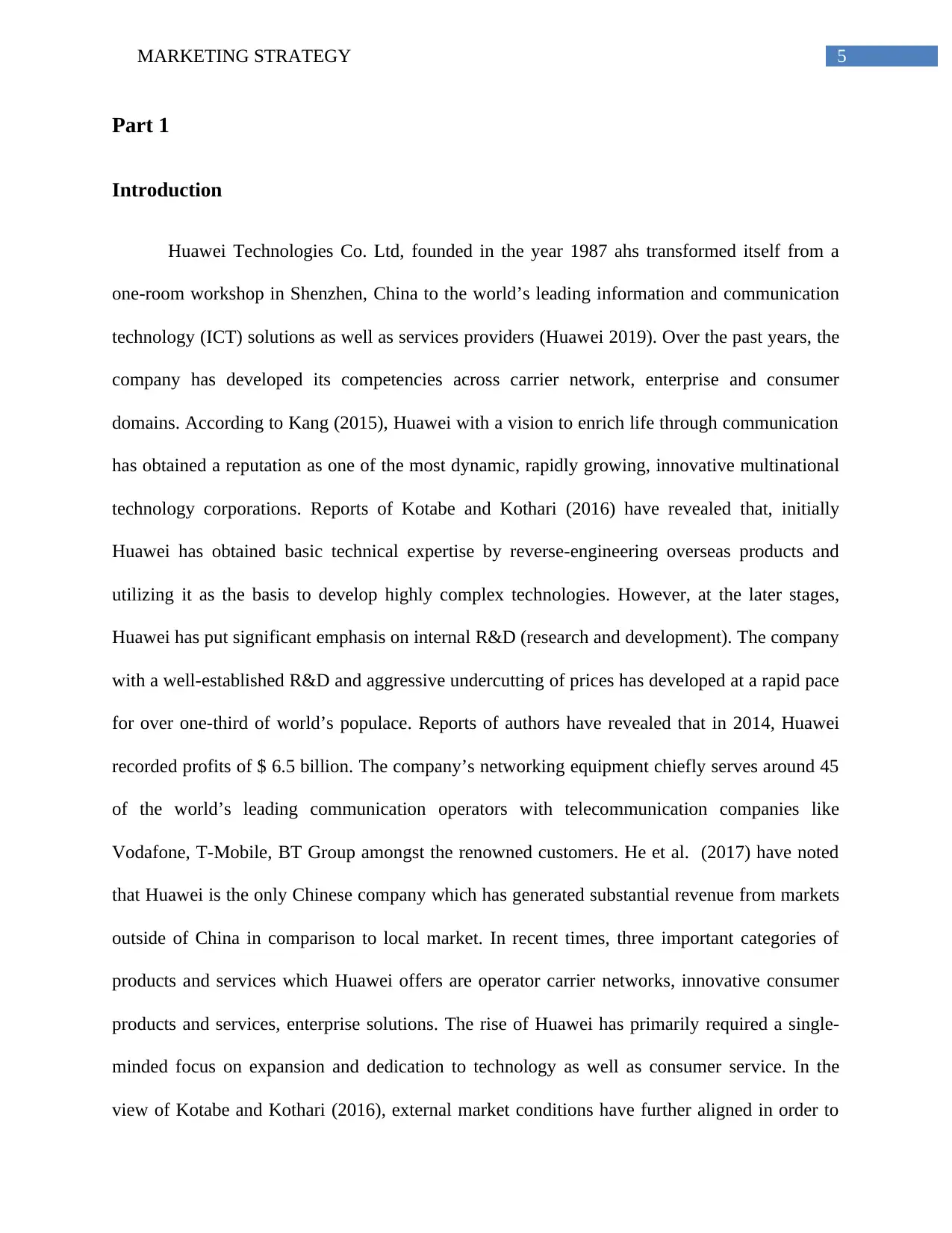
5MARKETING STRATEGY
Part 1
Introduction
Huawei Technologies Co. Ltd, founded in the year 1987 ahs transformed itself from a
one-room workshop in Shenzhen, China to the world’s leading information and communication
technology (ICT) solutions as well as services providers (Huawei 2019). Over the past years, the
company has developed its competencies across carrier network, enterprise and consumer
domains. According to Kang (2015), Huawei with a vision to enrich life through communication
has obtained a reputation as one of the most dynamic, rapidly growing, innovative multinational
technology corporations. Reports of Kotabe and Kothari (2016) have revealed that, initially
Huawei has obtained basic technical expertise by reverse-engineering overseas products and
utilizing it as the basis to develop highly complex technologies. However, at the later stages,
Huawei has put significant emphasis on internal R&D (research and development). The company
with a well-established R&D and aggressive undercutting of prices has developed at a rapid pace
for over one-third of world’s populace. Reports of authors have revealed that in 2014, Huawei
recorded profits of $ 6.5 billion. The company’s networking equipment chiefly serves around 45
of the world’s leading communication operators with telecommunication companies like
Vodafone, T-Mobile, BT Group amongst the renowned customers. He et al. (2017) have noted
that Huawei is the only Chinese company which has generated substantial revenue from markets
outside of China in comparison to local market. In recent times, three important categories of
products and services which Huawei offers are operator carrier networks, innovative consumer
products and services, enterprise solutions. The rise of Huawei has primarily required a single-
minded focus on expansion and dedication to technology as well as consumer service. In the
view of Kotabe and Kothari (2016), external market conditions have further aligned in order to
Part 1
Introduction
Huawei Technologies Co. Ltd, founded in the year 1987 ahs transformed itself from a
one-room workshop in Shenzhen, China to the world’s leading information and communication
technology (ICT) solutions as well as services providers (Huawei 2019). Over the past years, the
company has developed its competencies across carrier network, enterprise and consumer
domains. According to Kang (2015), Huawei with a vision to enrich life through communication
has obtained a reputation as one of the most dynamic, rapidly growing, innovative multinational
technology corporations. Reports of Kotabe and Kothari (2016) have revealed that, initially
Huawei has obtained basic technical expertise by reverse-engineering overseas products and
utilizing it as the basis to develop highly complex technologies. However, at the later stages,
Huawei has put significant emphasis on internal R&D (research and development). The company
with a well-established R&D and aggressive undercutting of prices has developed at a rapid pace
for over one-third of world’s populace. Reports of authors have revealed that in 2014, Huawei
recorded profits of $ 6.5 billion. The company’s networking equipment chiefly serves around 45
of the world’s leading communication operators with telecommunication companies like
Vodafone, T-Mobile, BT Group amongst the renowned customers. He et al. (2017) have noted
that Huawei is the only Chinese company which has generated substantial revenue from markets
outside of China in comparison to local market. In recent times, three important categories of
products and services which Huawei offers are operator carrier networks, innovative consumer
products and services, enterprise solutions. The rise of Huawei has primarily required a single-
minded focus on expansion and dedication to technology as well as consumer service. In the
view of Kotabe and Kothari (2016), external market conditions have further aligned in order to
⊘ This is a preview!⊘
Do you want full access?
Subscribe today to unlock all pages.

Trusted by 1+ million students worldwide
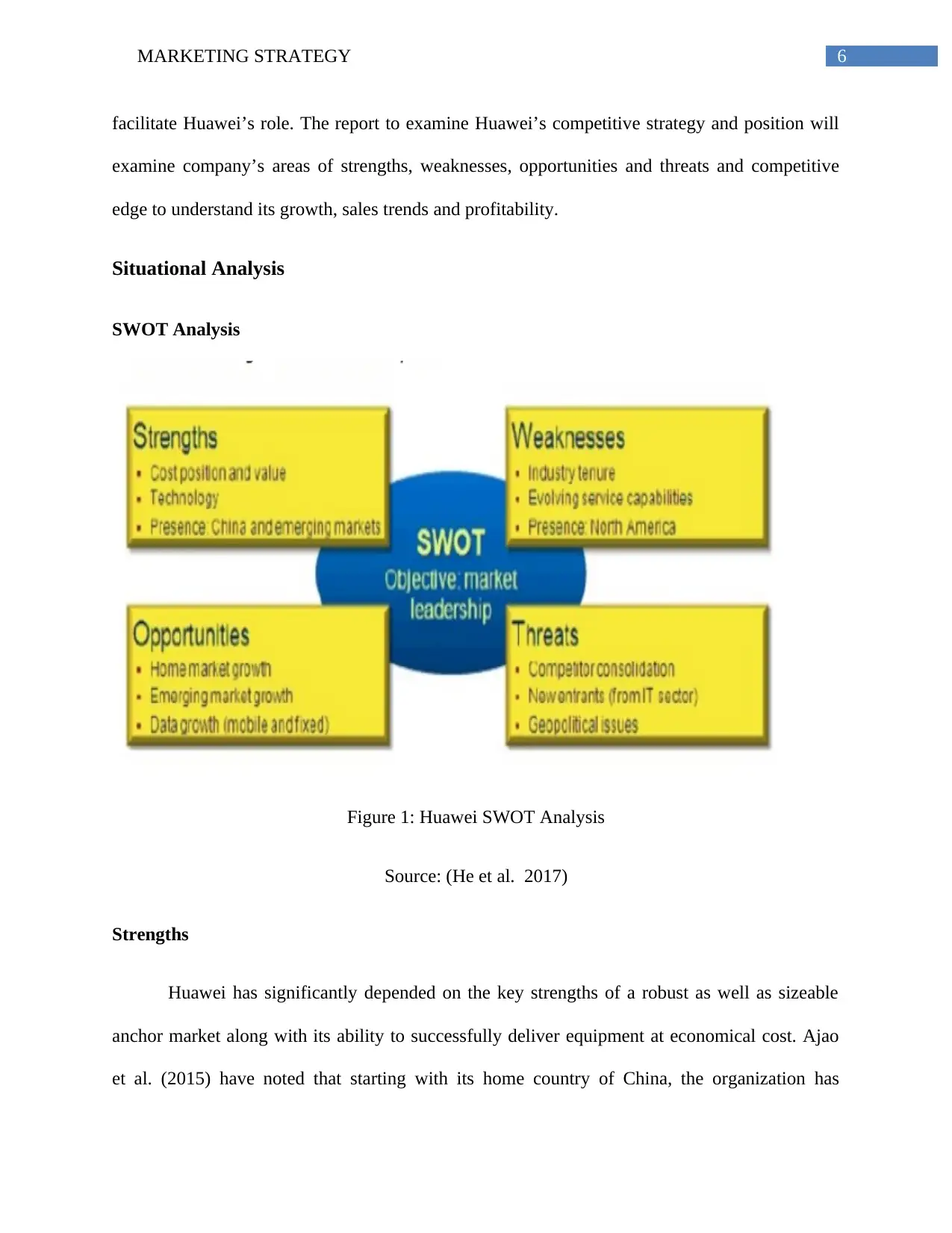
6MARKETING STRATEGY
facilitate Huawei’s role. The report to examine Huawei’s competitive strategy and position will
examine company’s areas of strengths, weaknesses, opportunities and threats and competitive
edge to understand its growth, sales trends and profitability.
Situational Analysis
SWOT Analysis
Figure 1: Huawei SWOT Analysis
Source: (He et al. 2017)
Strengths
Huawei has significantly depended on the key strengths of a robust as well as sizeable
anchor market along with its ability to successfully deliver equipment at economical cost. Ajao
et al. (2015) have noted that starting with its home country of China, the organization has
facilitate Huawei’s role. The report to examine Huawei’s competitive strategy and position will
examine company’s areas of strengths, weaknesses, opportunities and threats and competitive
edge to understand its growth, sales trends and profitability.
Situational Analysis
SWOT Analysis
Figure 1: Huawei SWOT Analysis
Source: (He et al. 2017)
Strengths
Huawei has significantly depended on the key strengths of a robust as well as sizeable
anchor market along with its ability to successfully deliver equipment at economical cost. Ajao
et al. (2015) have noted that starting with its home country of China, the organization has
Paraphrase This Document
Need a fresh take? Get an instant paraphrase of this document with our AI Paraphraser
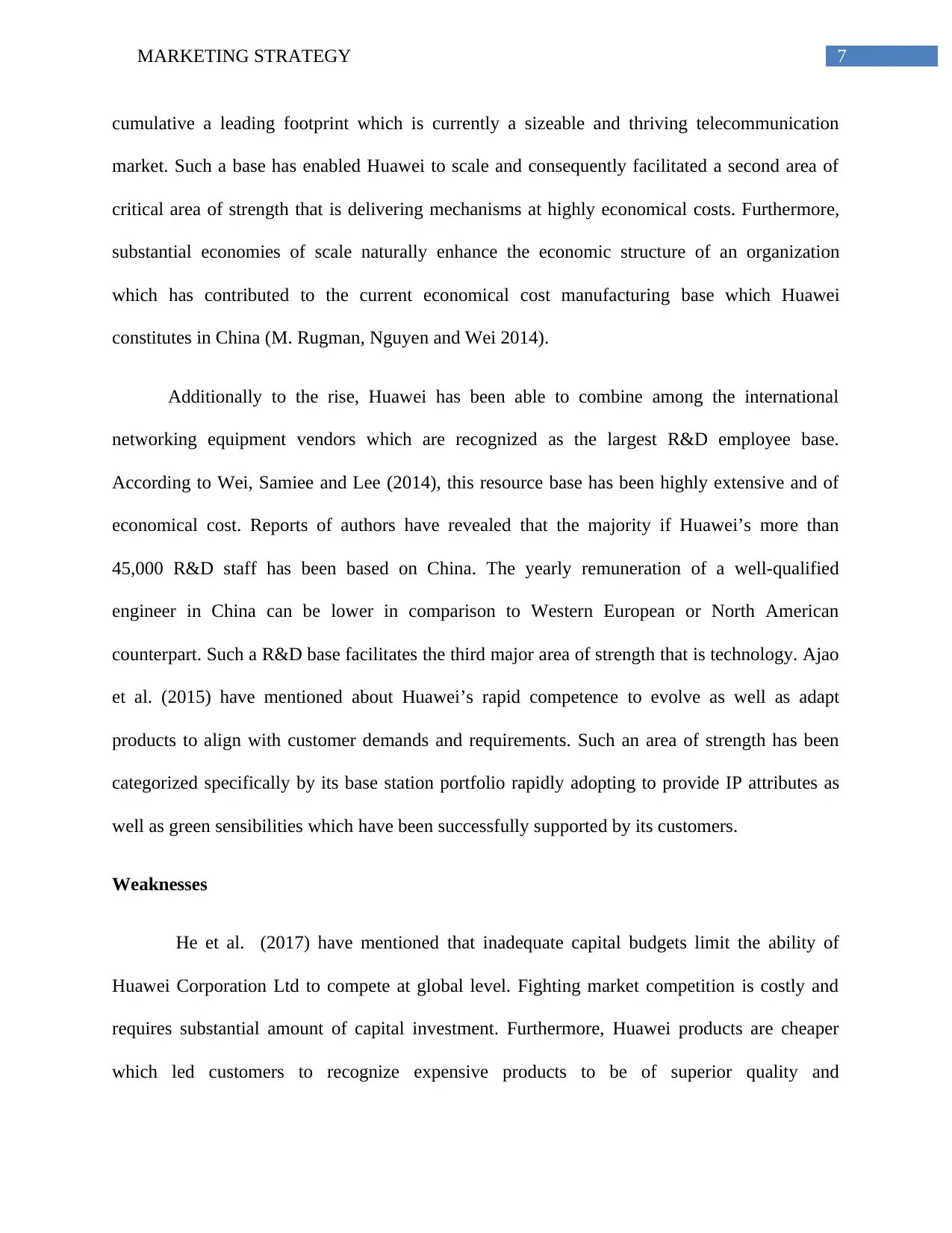
7MARKETING STRATEGY
cumulative a leading footprint which is currently a sizeable and thriving telecommunication
market. Such a base has enabled Huawei to scale and consequently facilitated a second area of
critical area of strength that is delivering mechanisms at highly economical costs. Furthermore,
substantial economies of scale naturally enhance the economic structure of an organization
which has contributed to the current economical cost manufacturing base which Huawei
constitutes in China (M. Rugman, Nguyen and Wei 2014).
Additionally to the rise, Huawei has been able to combine among the international
networking equipment vendors which are recognized as the largest R&D employee base.
According to Wei, Samiee and Lee (2014), this resource base has been highly extensive and of
economical cost. Reports of authors have revealed that the majority if Huawei’s more than
45,000 R&D staff has been based on China. The yearly remuneration of a well-qualified
engineer in China can be lower in comparison to Western European or North American
counterpart. Such a R&D base facilitates the third major area of strength that is technology. Ajao
et al. (2015) have mentioned about Huawei’s rapid competence to evolve as well as adapt
products to align with customer demands and requirements. Such an area of strength has been
categorized specifically by its base station portfolio rapidly adopting to provide IP attributes as
well as green sensibilities which have been successfully supported by its customers.
Weaknesses
He et al. (2017) have mentioned that inadequate capital budgets limit the ability of
Huawei Corporation Ltd to compete at global level. Fighting market competition is costly and
requires substantial amount of capital investment. Furthermore, Huawei products are cheaper
which led customers to recognize expensive products to be of superior quality and
cumulative a leading footprint which is currently a sizeable and thriving telecommunication
market. Such a base has enabled Huawei to scale and consequently facilitated a second area of
critical area of strength that is delivering mechanisms at highly economical costs. Furthermore,
substantial economies of scale naturally enhance the economic structure of an organization
which has contributed to the current economical cost manufacturing base which Huawei
constitutes in China (M. Rugman, Nguyen and Wei 2014).
Additionally to the rise, Huawei has been able to combine among the international
networking equipment vendors which are recognized as the largest R&D employee base.
According to Wei, Samiee and Lee (2014), this resource base has been highly extensive and of
economical cost. Reports of authors have revealed that the majority if Huawei’s more than
45,000 R&D staff has been based on China. The yearly remuneration of a well-qualified
engineer in China can be lower in comparison to Western European or North American
counterpart. Such a R&D base facilitates the third major area of strength that is technology. Ajao
et al. (2015) have mentioned about Huawei’s rapid competence to evolve as well as adapt
products to align with customer demands and requirements. Such an area of strength has been
categorized specifically by its base station portfolio rapidly adopting to provide IP attributes as
well as green sensibilities which have been successfully supported by its customers.
Weaknesses
He et al. (2017) have mentioned that inadequate capital budgets limit the ability of
Huawei Corporation Ltd to compete at global level. Fighting market competition is costly and
requires substantial amount of capital investment. Furthermore, Huawei products are cheaper
which led customers to recognize expensive products to be of superior quality and
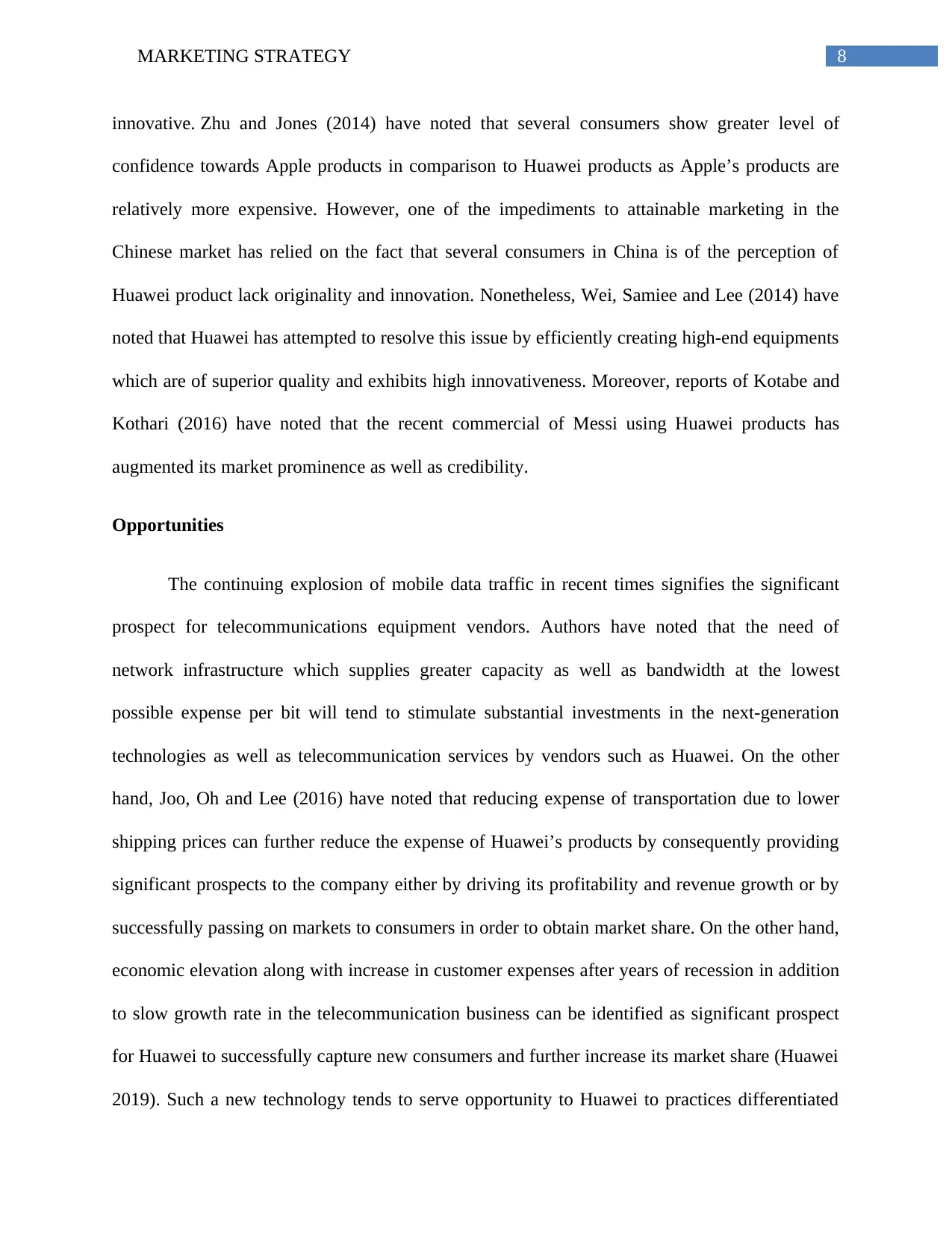
8MARKETING STRATEGY
innovative. Zhu and Jones (2014) have noted that several consumers show greater level of
confidence towards Apple products in comparison to Huawei products as Apple’s products are
relatively more expensive. However, one of the impediments to attainable marketing in the
Chinese market has relied on the fact that several consumers in China is of the perception of
Huawei product lack originality and innovation. Nonetheless, Wei, Samiee and Lee (2014) have
noted that Huawei has attempted to resolve this issue by efficiently creating high-end equipments
which are of superior quality and exhibits high innovativeness. Moreover, reports of Kotabe and
Kothari (2016) have noted that the recent commercial of Messi using Huawei products has
augmented its market prominence as well as credibility.
Opportunities
The continuing explosion of mobile data traffic in recent times signifies the significant
prospect for telecommunications equipment vendors. Authors have noted that the need of
network infrastructure which supplies greater capacity as well as bandwidth at the lowest
possible expense per bit will tend to stimulate substantial investments in the next-generation
technologies as well as telecommunication services by vendors such as Huawei. On the other
hand, Joo, Oh and Lee (2016) have noted that reducing expense of transportation due to lower
shipping prices can further reduce the expense of Huawei’s products by consequently providing
significant prospects to the company either by driving its profitability and revenue growth or by
successfully passing on markets to consumers in order to obtain market share. On the other hand,
economic elevation along with increase in customer expenses after years of recession in addition
to slow growth rate in the telecommunication business can be identified as significant prospect
for Huawei to successfully capture new consumers and further increase its market share (Huawei
2019). Such a new technology tends to serve opportunity to Huawei to practices differentiated
innovative. Zhu and Jones (2014) have noted that several consumers show greater level of
confidence towards Apple products in comparison to Huawei products as Apple’s products are
relatively more expensive. However, one of the impediments to attainable marketing in the
Chinese market has relied on the fact that several consumers in China is of the perception of
Huawei product lack originality and innovation. Nonetheless, Wei, Samiee and Lee (2014) have
noted that Huawei has attempted to resolve this issue by efficiently creating high-end equipments
which are of superior quality and exhibits high innovativeness. Moreover, reports of Kotabe and
Kothari (2016) have noted that the recent commercial of Messi using Huawei products has
augmented its market prominence as well as credibility.
Opportunities
The continuing explosion of mobile data traffic in recent times signifies the significant
prospect for telecommunications equipment vendors. Authors have noted that the need of
network infrastructure which supplies greater capacity as well as bandwidth at the lowest
possible expense per bit will tend to stimulate substantial investments in the next-generation
technologies as well as telecommunication services by vendors such as Huawei. On the other
hand, Joo, Oh and Lee (2016) have noted that reducing expense of transportation due to lower
shipping prices can further reduce the expense of Huawei’s products by consequently providing
significant prospects to the company either by driving its profitability and revenue growth or by
successfully passing on markets to consumers in order to obtain market share. On the other hand,
economic elevation along with increase in customer expenses after years of recession in addition
to slow growth rate in the telecommunication business can be identified as significant prospect
for Huawei to successfully capture new consumers and further increase its market share (Huawei
2019). Such a new technology tends to serve opportunity to Huawei to practices differentiated
⊘ This is a preview!⊘
Do you want full access?
Subscribe today to unlock all pages.

Trusted by 1+ million students worldwide
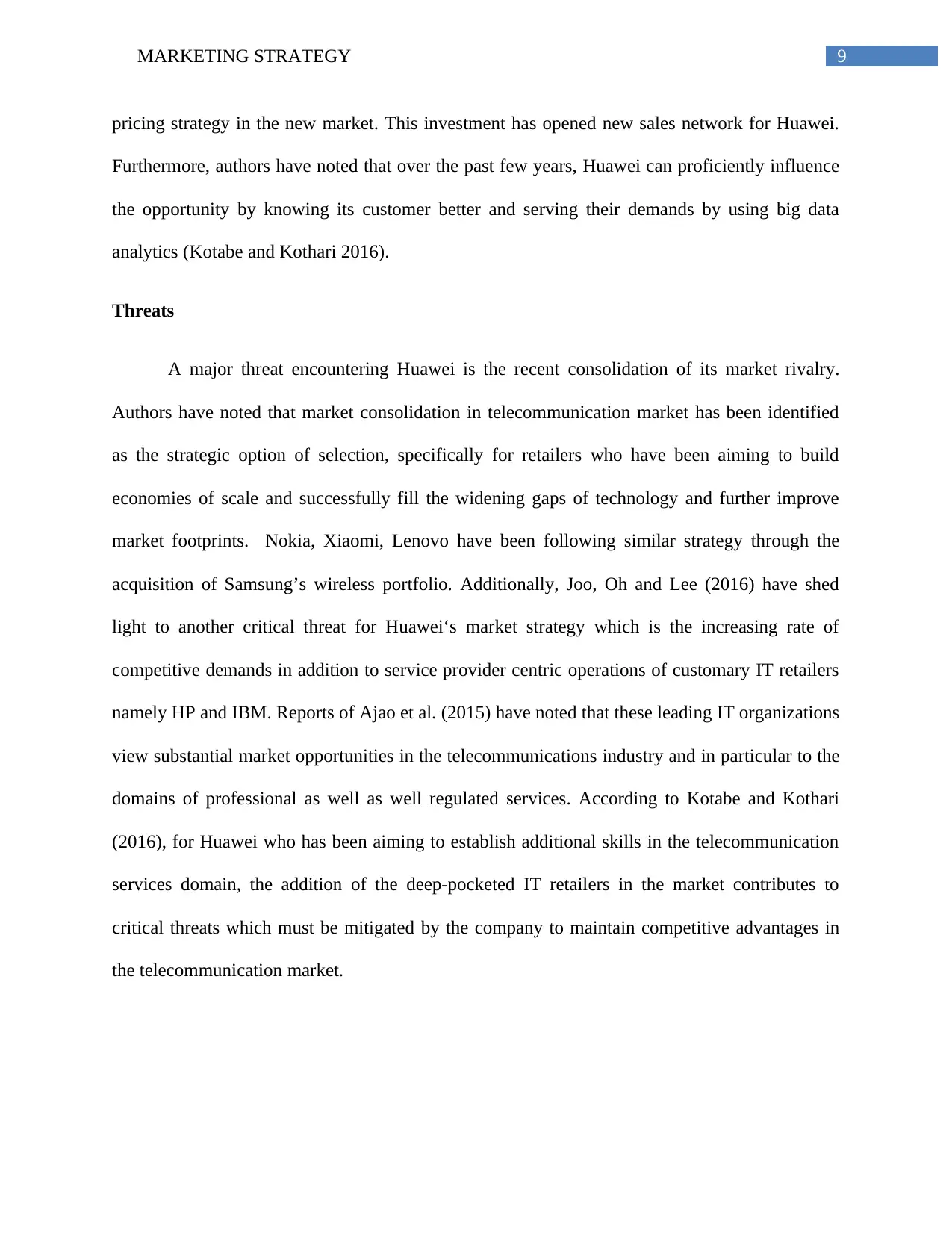
9MARKETING STRATEGY
pricing strategy in the new market. This investment has opened new sales network for Huawei.
Furthermore, authors have noted that over the past few years, Huawei can proficiently influence
the opportunity by knowing its customer better and serving their demands by using big data
analytics (Kotabe and Kothari 2016).
Threats
A major threat encountering Huawei is the recent consolidation of its market rivalry.
Authors have noted that market consolidation in telecommunication market has been identified
as the strategic option of selection, specifically for retailers who have been aiming to build
economies of scale and successfully fill the widening gaps of technology and further improve
market footprints. Nokia, Xiaomi, Lenovo have been following similar strategy through the
acquisition of Samsung’s wireless portfolio. Additionally, Joo, Oh and Lee (2016) have shed
light to another critical threat for Huawei‘s market strategy which is the increasing rate of
competitive demands in addition to service provider centric operations of customary IT retailers
namely HP and IBM. Reports of Ajao et al. (2015) have noted that these leading IT organizations
view substantial market opportunities in the telecommunications industry and in particular to the
domains of professional as well as well regulated services. According to Kotabe and Kothari
(2016), for Huawei who has been aiming to establish additional skills in the telecommunication
services domain, the addition of the deep-pocketed IT retailers in the market contributes to
critical threats which must be mitigated by the company to maintain competitive advantages in
the telecommunication market.
pricing strategy in the new market. This investment has opened new sales network for Huawei.
Furthermore, authors have noted that over the past few years, Huawei can proficiently influence
the opportunity by knowing its customer better and serving their demands by using big data
analytics (Kotabe and Kothari 2016).
Threats
A major threat encountering Huawei is the recent consolidation of its market rivalry.
Authors have noted that market consolidation in telecommunication market has been identified
as the strategic option of selection, specifically for retailers who have been aiming to build
economies of scale and successfully fill the widening gaps of technology and further improve
market footprints. Nokia, Xiaomi, Lenovo have been following similar strategy through the
acquisition of Samsung’s wireless portfolio. Additionally, Joo, Oh and Lee (2016) have shed
light to another critical threat for Huawei‘s market strategy which is the increasing rate of
competitive demands in addition to service provider centric operations of customary IT retailers
namely HP and IBM. Reports of Ajao et al. (2015) have noted that these leading IT organizations
view substantial market opportunities in the telecommunications industry and in particular to the
domains of professional as well as well regulated services. According to Kotabe and Kothari
(2016), for Huawei who has been aiming to establish additional skills in the telecommunication
services domain, the addition of the deep-pocketed IT retailers in the market contributes to
critical threats which must be mitigated by the company to maintain competitive advantages in
the telecommunication market.
Paraphrase This Document
Need a fresh take? Get an instant paraphrase of this document with our AI Paraphraser
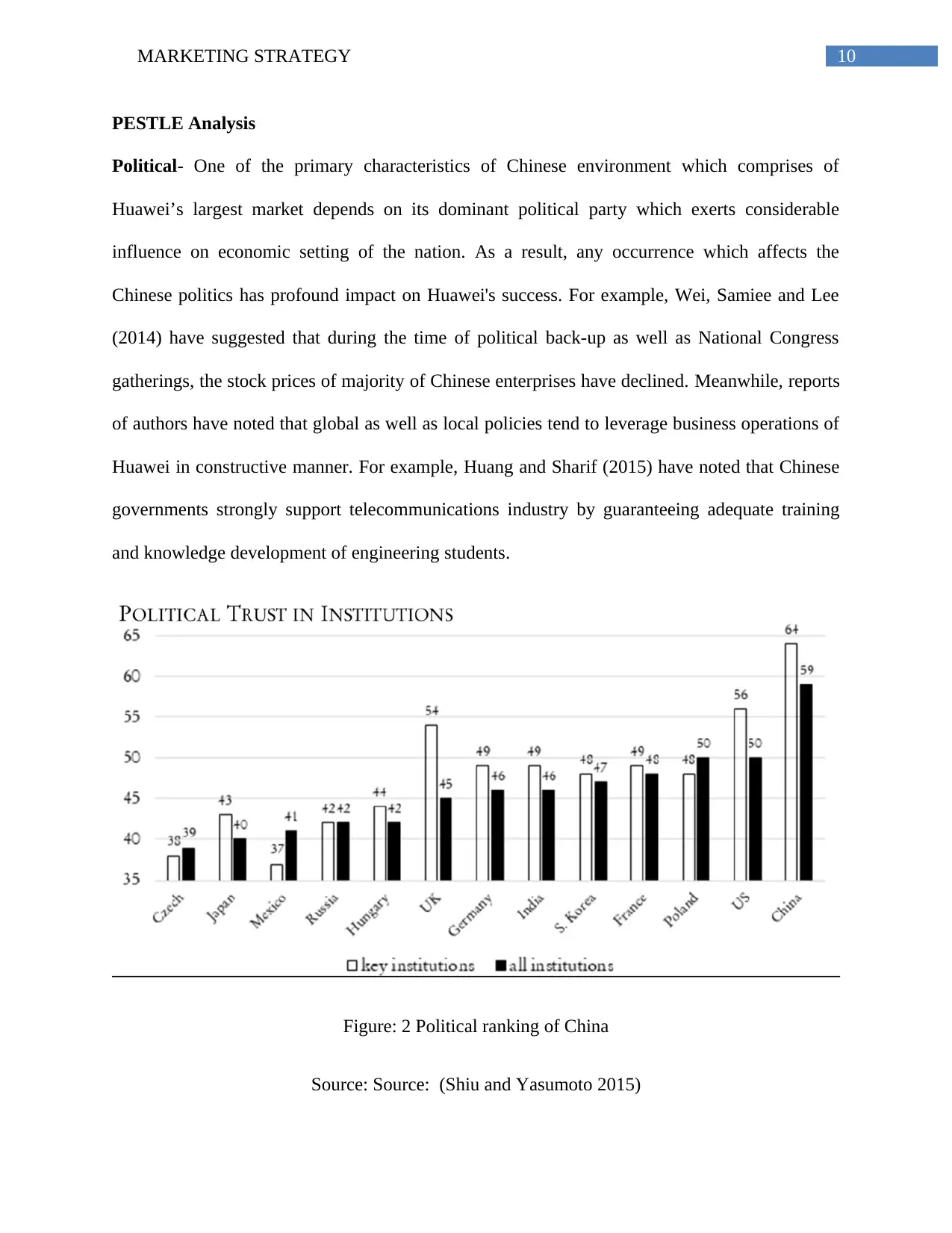
10MARKETING STRATEGY
PESTLE Analysis
Political- One of the primary characteristics of Chinese environment which comprises of
Huawei’s largest market depends on its dominant political party which exerts considerable
influence on economic setting of the nation. As a result, any occurrence which affects the
Chinese politics has profound impact on Huawei's success. For example, Wei, Samiee and Lee
(2014) have suggested that during the time of political back-up as well as National Congress
gatherings, the stock prices of majority of Chinese enterprises have declined. Meanwhile, reports
of authors have noted that global as well as local policies tend to leverage business operations of
Huawei in constructive manner. For example, Huang and Sharif (2015) have noted that Chinese
governments strongly support telecommunications industry by guaranteeing adequate training
and knowledge development of engineering students.
Figure: 2 Political ranking of China
Source: Source: (Shiu and Yasumoto 2015)
PESTLE Analysis
Political- One of the primary characteristics of Chinese environment which comprises of
Huawei’s largest market depends on its dominant political party which exerts considerable
influence on economic setting of the nation. As a result, any occurrence which affects the
Chinese politics has profound impact on Huawei's success. For example, Wei, Samiee and Lee
(2014) have suggested that during the time of political back-up as well as National Congress
gatherings, the stock prices of majority of Chinese enterprises have declined. Meanwhile, reports
of authors have noted that global as well as local policies tend to leverage business operations of
Huawei in constructive manner. For example, Huang and Sharif (2015) have noted that Chinese
governments strongly support telecommunications industry by guaranteeing adequate training
and knowledge development of engineering students.
Figure: 2 Political ranking of China
Source: Source: (Shiu and Yasumoto 2015)
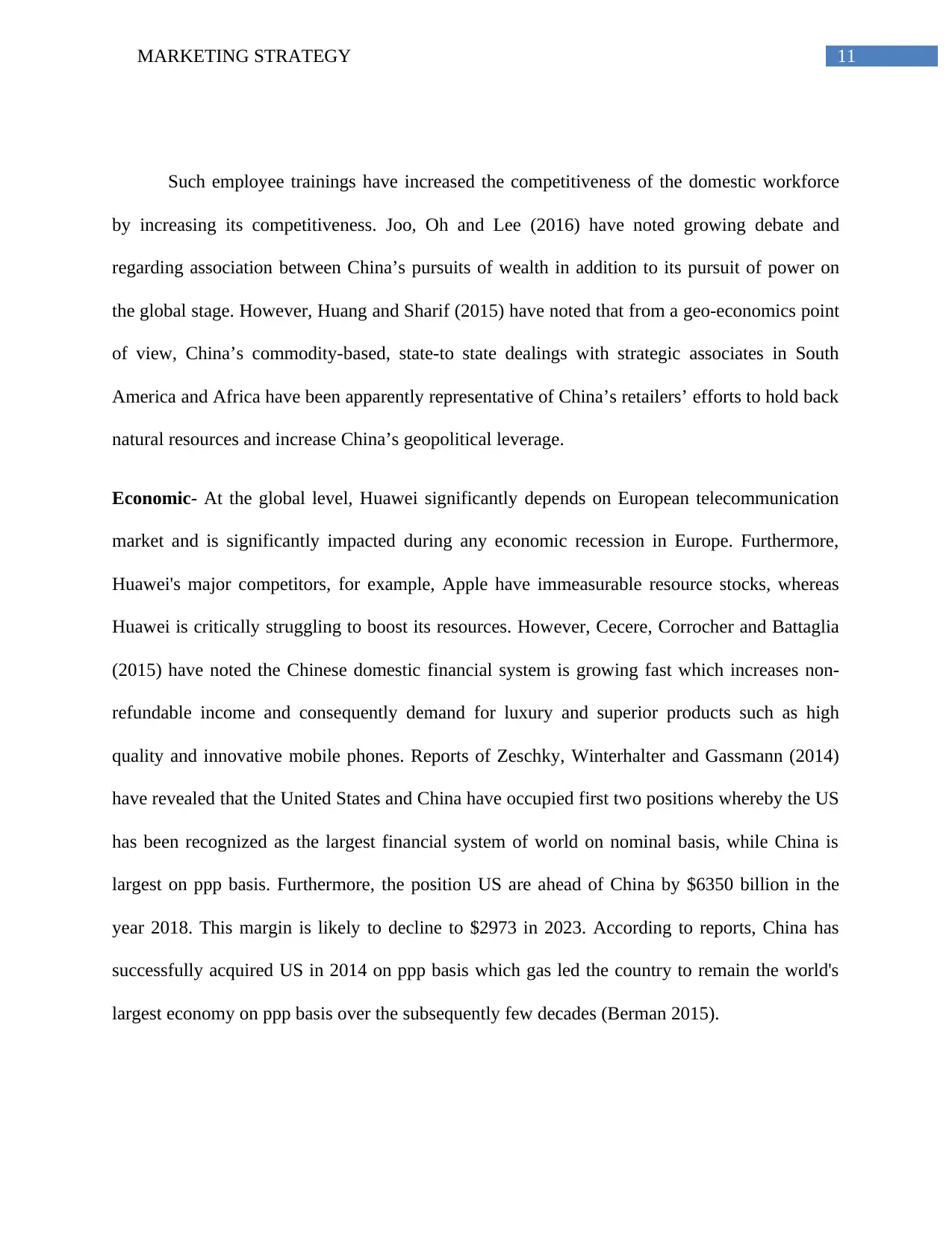
11MARKETING STRATEGY
Such employee trainings have increased the competitiveness of the domestic workforce
by increasing its competitiveness. Joo, Oh and Lee (2016) have noted growing debate and
regarding association between China’s pursuits of wealth in addition to its pursuit of power on
the global stage. However, Huang and Sharif (2015) have noted that from a geo-economics point
of view, China’s commodity-based, state-to state dealings with strategic associates in South
America and Africa have been apparently representative of China’s retailers’ efforts to hold back
natural resources and increase China’s geopolitical leverage.
Economic- At the global level, Huawei significantly depends on European telecommunication
market and is significantly impacted during any economic recession in Europe. Furthermore,
Huawei's major competitors, for example, Apple have immeasurable resource stocks, whereas
Huawei is critically struggling to boost its resources. However, Cecere, Corrocher and Battaglia
(2015) have noted the Chinese domestic financial system is growing fast which increases non-
refundable income and consequently demand for luxury and superior products such as high
quality and innovative mobile phones. Reports of Zeschky, Winterhalter and Gassmann (2014)
have revealed that the United States and China have occupied first two positions whereby the US
has been recognized as the largest financial system of world on nominal basis, while China is
largest on ppp basis. Furthermore, the position US are ahead of China by $6350 billion in the
year 2018. This margin is likely to decline to $2973 in 2023. According to reports, China has
successfully acquired US in 2014 on ppp basis which gas led the country to remain the world's
largest economy on ppp basis over the subsequently few decades (Berman 2015).
Such employee trainings have increased the competitiveness of the domestic workforce
by increasing its competitiveness. Joo, Oh and Lee (2016) have noted growing debate and
regarding association between China’s pursuits of wealth in addition to its pursuit of power on
the global stage. However, Huang and Sharif (2015) have noted that from a geo-economics point
of view, China’s commodity-based, state-to state dealings with strategic associates in South
America and Africa have been apparently representative of China’s retailers’ efforts to hold back
natural resources and increase China’s geopolitical leverage.
Economic- At the global level, Huawei significantly depends on European telecommunication
market and is significantly impacted during any economic recession in Europe. Furthermore,
Huawei's major competitors, for example, Apple have immeasurable resource stocks, whereas
Huawei is critically struggling to boost its resources. However, Cecere, Corrocher and Battaglia
(2015) have noted the Chinese domestic financial system is growing fast which increases non-
refundable income and consequently demand for luxury and superior products such as high
quality and innovative mobile phones. Reports of Zeschky, Winterhalter and Gassmann (2014)
have revealed that the United States and China have occupied first two positions whereby the US
has been recognized as the largest financial system of world on nominal basis, while China is
largest on ppp basis. Furthermore, the position US are ahead of China by $6350 billion in the
year 2018. This margin is likely to decline to $2973 in 2023. According to reports, China has
successfully acquired US in 2014 on ppp basis which gas led the country to remain the world's
largest economy on ppp basis over the subsequently few decades (Berman 2015).
⊘ This is a preview!⊘
Do you want full access?
Subscribe today to unlock all pages.

Trusted by 1+ million students worldwide
1 out of 32
Related Documents
Your All-in-One AI-Powered Toolkit for Academic Success.
+13062052269
info@desklib.com
Available 24*7 on WhatsApp / Email
![[object Object]](/_next/static/media/star-bottom.7253800d.svg)
Unlock your academic potential
Copyright © 2020–2025 A2Z Services. All Rights Reserved. Developed and managed by ZUCOL.





